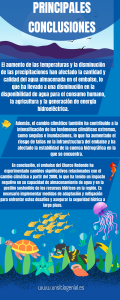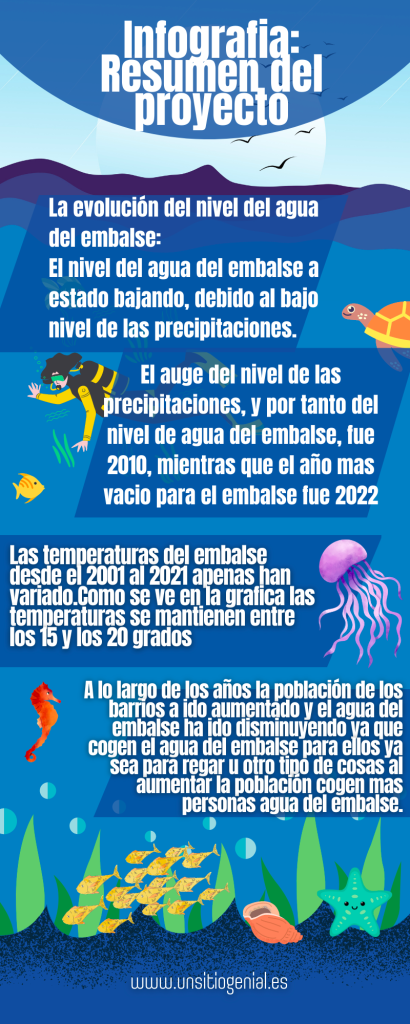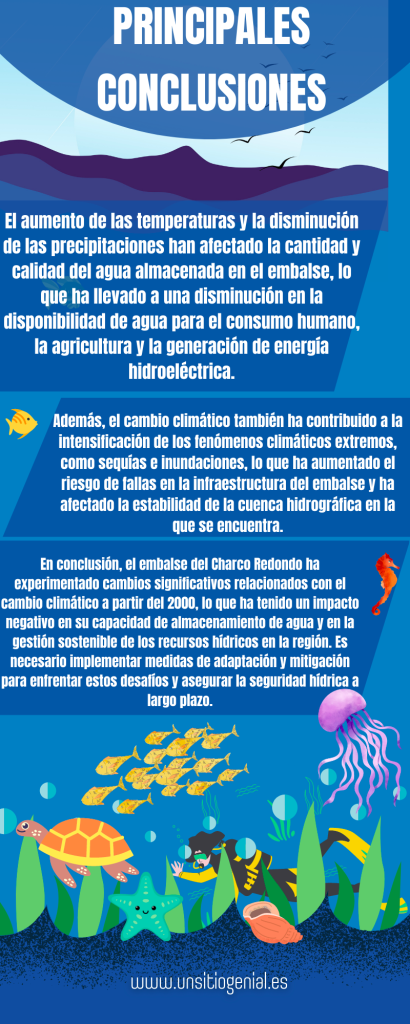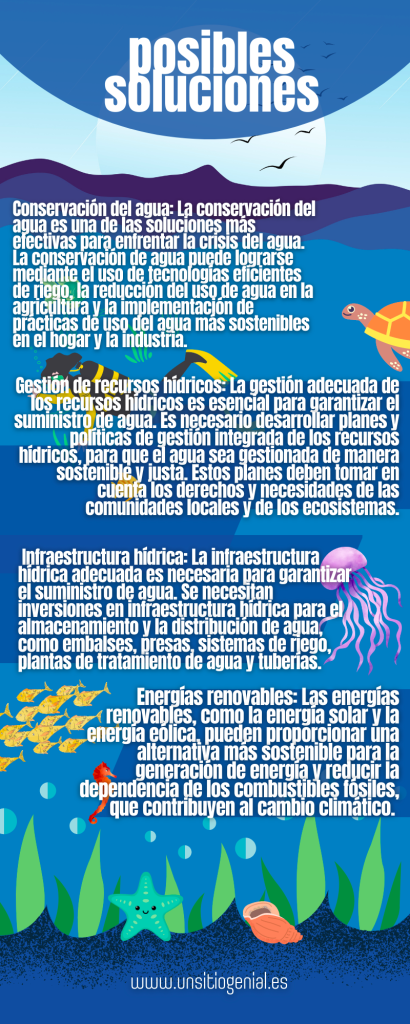Climate Detectives Projects 2022-2023
Project title: Study of sediment in the Charco Redondo Reservoir
Team: IES SAN SEVERIANO 4º ESO CHARCO
Avenida San Severiano Cádiz Spain 4 Student’s age: 14-15 years old, 16-17 years old
How does climate change affect the Charco Redondo reservoir?
¿Cómo afecta el cambio climático al embalse de Charco Redondo?

Climate change has had a devastating impact on many water bodies around the world, and the Charco Redondo reservoir is no exception. This reservoir, located in a semi-arid area, has suffered the effects of drought and reduced rainfall.
In the year 2022, the reservoir is at 21.54% of its capacity, which represents a significant decrease compared to the previous year, when it had 18.87 cubic hectometres of reservoir capacity. The low level of rainfall has been the main cause of this decrease in the reservoir’s capacity.
Over the years, the population of Los Barrios, a town close to the reservoir, has been increasing, which has contributed to an increased demand for water. This has put additional pressure on the reservoir, as more and more people are using the water for their daily needs, such as irrigation and other domestic uses.
Despite this, we analysed the temperatures of the reservoir, and we can see that they have hardly changed from 2001 to 2021, as can be seen in the graph of the research, where they remain between 15 and 20 degrees Celsius. This indicates that climate change has not had a significant impact on reservoir temperatures, but it has had a significant impact on the amount of water available.
In summary, the Charco Redondo reservoir has experienced a decrease in capacity due to drought and reduced rainfall caused by climate change. In addition, the increasing demand for water by the population has put additional pressure on the reservoir. It is essential to take measures to protect water resources and ensure their long-term sustainability.
El cambio climático ha tenido un impacto devastador en muchas masas de agua en todo el mundo, y el embalse de Charco Redondo no es una excepción. Este embalse, ubicado en una zona semiárida, ha sufrido los efectos de la sequía y la disminución de las precipitaciones.
En el año 2022, el embalse se encuentra al 21,54% de su capacidad, lo que representa una disminución significativa en comparación con el año anterior, cuando tenía 18,87 hectómetros cúbicos embalsados. El bajo nivel de precipitaciones ha sido la principal causa de esta disminución en la capacidad del embalse.
A lo largo de los años, la población de Los Barrios, población cercana al embalse, ha ido en aumento, lo que ha contribuido a una mayor demanda de agua. Esto ha generado una presión adicional sobre el embalse, ya que cada vez más personas están usando el agua para sus necesidades cotidianas, como el riego y otros usos domésticos.
A pesar de esto, analizamos las temperaturas del embalse, pudiendo comprobar como apenas han variado desde el año 2001 hasta el 2021, como se puede observar en la gráfica de la investigación, donde se mantienen entre los 15 y los 20 grados centígrados. Esto indica que el cambio climático no ha tenido un impacto significativo en las temperaturas del embalse, pero sí en la cantidad de agua disponible.
En resumen, el embalse de Charco Redondo ha experimentado una disminución en su capacidad debido a la sequía y la disminución de las precipitaciones causadas por el cambio climático. Además, la creciente demanda de agua por parte de la población ha ejercido una presión adicional sobre el embalse. Es esencial tomar medidas para proteger los recursos hídricos y garantizar su sostenibilidad a largo plazo.

Rising temperatures and decreasing rainfall have affected the quantity and quality of water stored in the reservoir, leading to a decrease in the availability of water for human consumption, agriculture and hydropower generation.
In addition, climate change has also contributed to the intensification of extreme weather events, such as droughts and floods, which has increased the risk of failure of the reservoir’s infrastructure and affected the stability of the watershed in which it is located.
In conclusion, the Charco Redondo reservoir has experienced significant changes related to climate change since 2000, which has had a negative impact on its water storage capacity and the sustainable management of water resources in the region. Adaptation and mitigation measures need to be implemented to address these challenges and ensure long-term water security.
El aumento de las temperaturas y la disminución de las precipitaciones han afectado la cantidad y calidad del agua almacenada en el embalse, lo que ha llevado a una disminución en la disponibilidad de agua para el consumo humano, la agricultura y la generación de energía hidroeléctrica.
Además, el cambio climático también ha contribuido a la intensificación de los fenómenos climáticos extremos, como sequías e inundaciones, lo que ha aumentado el riesgo de fallas en la infraestructura del embalse y ha afectado la estabilidad de la cuenca hidrográfica en la que se encuentra.
En conclusión, el embalse del Charco Redondo ha experimentado cambios significativos relacionados con el cambio climático a partir del 2000, lo que ha tenido un impacto negativo en su capacidad de almacenamiento de agua y en la gestión sostenible de los recursos hídricos en la región. Es necesario implementar medidas de adaptación y mitigación para enfrentar estos desafíos y asegurar la seguridad hídrica a largo plazo.

The following are some of the possible actions that would ameliorate the problem identified:
Water resources management: Proper management of water resources is essential to secure water supply. Integrated water resources management plans and policies need to be developed so that water is managed sustainably and fairly. These plans must take into account the rights and needs of local communities and ecosystems.
Water conservation: Water conservation is one of the most effective solutions to address the water crisis. Water conservation can be achieved through the use of efficient irrigation technologies, reducing water use in agriculture and implementing more sustainable water use practices in households and industry.
Water infrastructure: Adequate water infrastructure is necessary to secure water supply. Investments in water infrastructure are needed for water storage and distribution, such as reservoirs, dams, irrigation systems, water treatment plants and pipelines.
Se muestran a continuación algunas de las posibles acciones que aminorarían el problema detectado:
Gestión de recursos hídricos: La gestión adecuada de los recursos hídricos es esencial para garantizar el suministro de agua. Es necesario desarrollar planes y políticas de gestión integrada de los recursos hídricos, para que el agua sea gestionada de manera sostenible y justa. Estos planes deben tomar en cuenta los derechos y necesidades de las comunidades locales y de los ecosistemas.
Conservación del agua: La conservación del agua es una de las soluciones más efectivas para enfrentar la crisis del agua. La conservación de agua puede lograrse mediante el uso de tecnologías eficientes de riego, la reducción del uso de agua en la agricultura y la implementación de prácticas de uso del agua más sostenibles en el hogar y la industria.
Infraestructura hídrica: La infraestructura hídrica adecuada es necesaria para garantizar el suministro de agua. Se necesitan inversiones en infraestructura hídrica para el almacenamiento y la distribución de agua, como embalses, presas, sistemas de riego, plantas de tratamiento de agua y tuberías.
https://sites.google.com/view/embalsedelcharcoredondo/inicio?authuser=1
This project was automatically translated into English.
Projects are created by the teams and they take the full responsibility of the shared data.
← All projects





